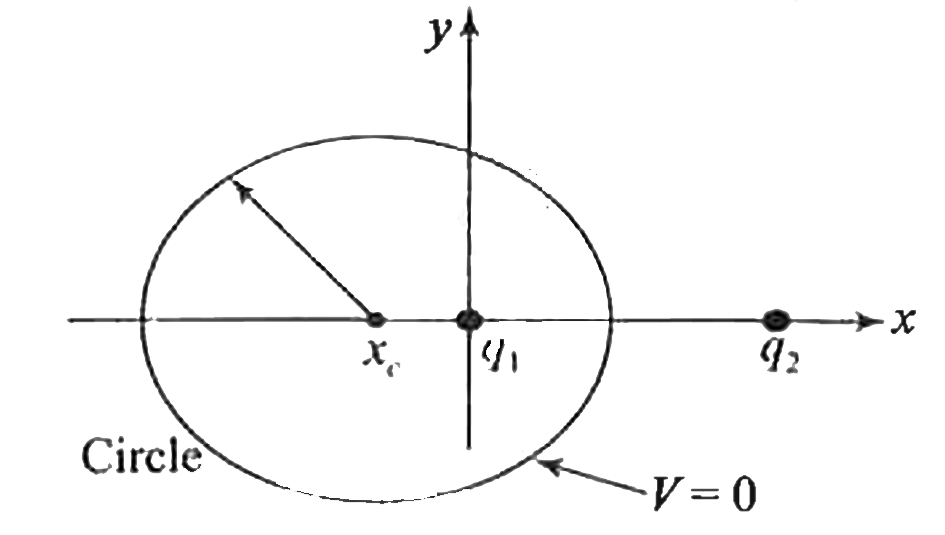Complete Solutions to DPP 3.1 of chapter ELECTRIC POTENTIAL of Class 12 book with complete answers and questions
| Class 12 | PHYSICS |
| Chapter | ELECTRIC POTENTIAL |
| CENGAGE PHYSICS DPP | DPP 3.1 |
| Number Of Questions | 14 |
| Academic Year | 2023-24 |
Three is an electric field E in the x - direction. If the work done by the electric field in moving a charge of `0.2 C` through a distance of `2 m` along a line making an angle `60^(@)` with the x- axis is `4 J`, then what is the value of E ?
View SolutionFour equal charges `Q` are placed at the four corners of a square of each side is 'a'. Work done in removing a charge `-Q` from its centre to infinity is
View SolutionCharges of `+(10)/(3) xx 10^(-9) C` are placed at each of the four corners of a square of side `8 cm`. The potential at the intersection of the diagonals is
View SolutionThree charges `2q, -q, and -q` are located at the vertices of an equilateral triangle. At the center of the triangle,
View SolutionTwo electric charges `12 mu C` and `-6 mu C` are placed `20 cm` apart in air. There will be a point `P` on the line joining these charges and outside the region between them, at which the electric potential is zero. The distance of `P` from `6 mu C` chrage is
View SolutionA spherical conductor of radius `2 m` is charged to a potential of `120 V`. It is now placed inside another hollow spherical conductor of radius `6 m`. Calculate the potential to which the bigger sphere would be raised
View SolutionTwo point charges `100 mu C` and `5 mu C` are placed at points `A and B` respectively with `AB = 40 cm`. The work done by external froce in displacing the charge `5 mu C` from B to C, where `BC = 30 cm`, angle `ABC = (pi)/(2)` and `(1)/(4pi epsilon_(0)) = 9 xx 10^(9)Nm^(2)//C^(2)`
View SolutionIn the rectangle, shown below, the two corners have charges `q_(1) = - 5mu C` and `q_(2) = + 2.0 mu C`. The work done in moving a charge `+3.0 mu C` from `B to A` is (take `1//4 4pi epsilon_(0) = 10^(10) N-m^(2)//C^(2))`

View SolutionA charge `(-q)` and another charge `(Q)` are kept at two points `A and B` respectively. Keeping the charge `(+Q)` fixed at `B`, the charge `(-q)` at `A` is moved to another point `C` such that `ABC` forms an equilateral triangle of side `l`. The net work done in moving teh charge `(-q)` is
View SolutionA point charge is surrounded symmetrically by six identical charges at distance `r` as shown in the figure How much work is done by the froces of electrostatic repulsion when the point charge at the centre is removed to infinity ?

View SolutionAn electric field 'E' whose direction is radially outward varies as distance from origin 'r' as shown in the graph E is taken as positive if its direction is away from the origin. Then the work done by electric field on a 2 C charge if it is taken from `(1,1,0)` to `(3,0,0)` is :

View Solution
A point charge `q_(1)=+6e` fixed at the origin of a coordinate system, and another point charge `q_(2)=-10e` is fixed at `x=8nm`, `y=0` the locus of all points in the xy plane for which potential `V=0` (other man inifinity) is a circle centered on the x-axis as shown.
Q. Radius R of the circle is
View SolutionA point charge `q_(1)=+6e` fixed at the origin of a conducting system, and another point charge `q_(2) = -10e` is fixed at `x=8` nm, `y=0`. The locus of all points in the `xy` plane for which potential `V=0` (other than infinity) is a circle consider on the x-axis, as shown

x-coordinate of the centre of the circle is
View Solution
A point charge `q_(1)=+6e` fixed at the origin of a coordinate system, and another point charge `q_(2)=-10e` is fixed at `x=8nm`, `y=0` the locus of all points in the xy plane for which potential `V=0` (other man inifinity) is a circle centered on the x-axis as shown.
Q. The potential at the centre of the circle is
View Solution
DPP 3.1 questions and complete solutions for chapter ELECTRIC POTENTIAL of CENGAGE PHYSICS (HINGLISH) of Class 12